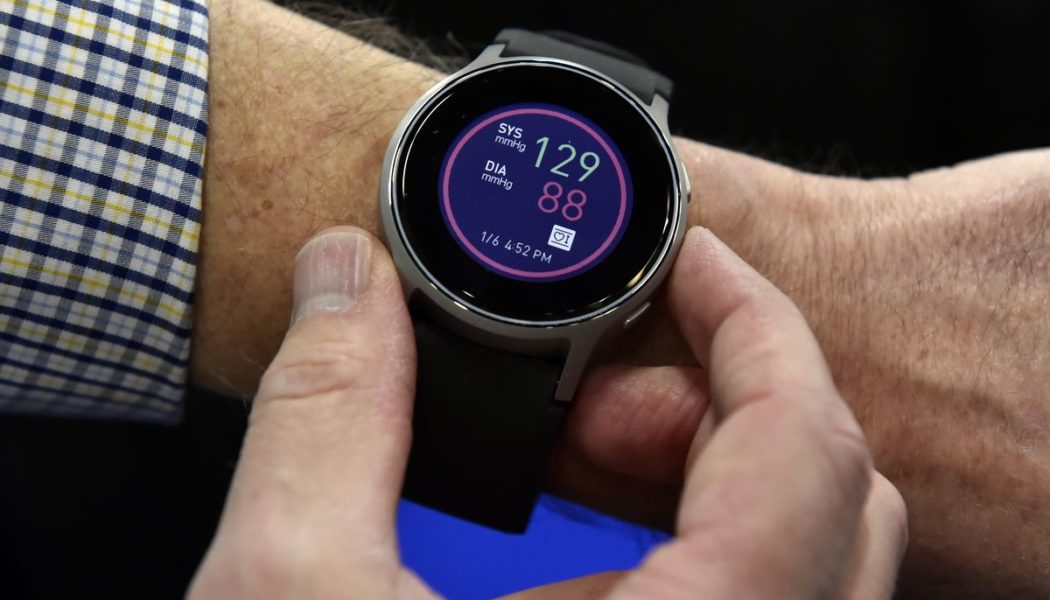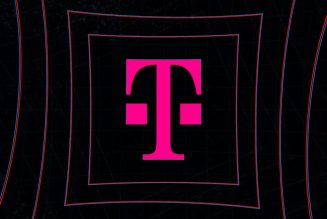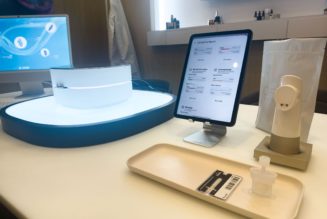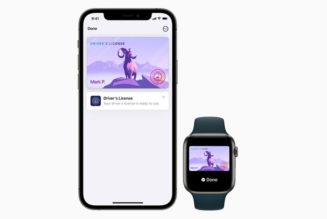It’s been over two years since Samsung first announced that its Galaxy Watch would be able to measure people’s blood pressure. The feature is available in a number of countries, including South Korea, but not in the United States — the company is still awaiting Food and Drug Administration clearance. In the meantime, other smartwatch companies have started experimenting with blood pressure tech in a bid for monitors on their devices. Fitbit announced a study trialing a blood pressure monitor in April, and Apple is reportedly working on its own version, as well.
Adding a blood pressure monitor to smartwatches could arguably be more important for users’ cardiovascular health than the heart rate and rhythm monitors they have now, says says Ann Marie Navar, a cardiologist at the University of Texas Southwestern Medical Center. “Blood pressure measurement is something we need to do a lot more a lot of,” she says.
But it’s still not clear how reliable smartwatch-measured blood pressure could be. Measuring blood pressure is much harder than tracking heart rate and rhythm, and getting it right is arguably even more important. “We’re not ready for primetime yet,” says Jordana Cohen, an assistant professor of medicine at the University of Pennsylvania who studies hypertension.
Squeeze-free methods
Having more ways to easily take blood pressure measurements at home could be a big benefit to people with hypertension (high blood pressure) or other concerns. Pressure measurements taken exclusively in a doctor’s office are often unreliable: some people have higher blood pressure in-office because they’re anxious about the visit, while other people have masked hypertension — high blood pressure at home, but normal blood pressure at the doctor. “We don’t pick it up unless we have people check their blood pressures at home,” Navar says.
There are plenty of at-home blood pressure cuffs that take the standard approach: a cuff gets strapped onto a patient’s upper arm. Inflating the cuff cuts off blood flow, and the device measures the pressure blood is putting on vessel walls when blood starts flowing again as the compression is released.
:no_upscale()/cdn.vox-cdn.com/uploads/chorus_asset/file/22855694/1090712796.jpg)
Right now, there’s one wearable device cleared by the Food and Drug Administration to measure blood pressure: a device from medical equipment company Omron, which has an inflatable cuff inside the band that lets it take blood pressure measurements at the wrist using the traditional squeezing method. Unlike smartwatches that are hoping to add blood pressure to existing tech, Omron’s HeartGuide is extremely specialized. It’s even marketed as “a wearable blood pressure monitor in the innovative form of a wristwatch”
Smartwatch companies like Samsung and Fitbit are taking another approach. They are using light sensors on the smartwatches to calculate blood pressure. It’s a big challenge, says Wendy Mendes, a psychophysiologist at the University of California San Francisco who works with Samsung on its tool.
Samsung’s approach is based on a measure called pulse transit time, which is the time between the contraction of the heart and when the pulse arrives at a particular body part, like the wrist. It’s correlated with blood pressure. “The faster that pulse transit time is, the more the vessels are tightening — that’s what’s making the pulse travel faster,” Mendes says. Optical sensors also check if vessels are tightening or widening. An algorithm then uses those two bits of information, along with heart rate, to estimate blood pressure.
Fitbit is a few steps further back in the process — it doesn’t have any blood pressure features available but has a handful of studies underway looking at the relationship between the metrics already collected by its devices and blood pressure. They’re focusing on a measure called pulse arrival time. It’s similar to pulse transit time but measures the pulse at a slightly different time than Samsung does, says Eric Friedman, vice president of research at Fitbit.
:no_upscale()/cdn.vox-cdn.com/uploads/chorus_asset/file/22855654/Samsung_Health_Monitor_App_Blood_Pressure_dl2.jpg)
There’s a limitation to both of these strategies: generally, they can only reliably measure relative blood pressure. Mendes could strap a watch on and find out if someone’s blood pressure was higher in the morning than it was when they went to sleep the previous night, but wouldn’t be able to tell what the raw number it started at was without benchmarking the device off of a standard blood pressure cuff. “Almost all of these sensors are going to be good at changes,” she says. “But to get the level, you have to calibrate it.” Samsung suggests users recalibrate the blood pressure monitor on their smartwatches every four weeks.
Apple’s blood pressure feature is still in development and has not been formally announced. It would reportedly just give people information on trends in their blood pressure — if it’s increasing or decreasing — rather than a raw measure, which requires the calibration step used by Samsung, according to The Wall Street Journal. That’s a more realistic approach, Cohen says, because the techniques used in smartwatches are much more capable of detecting relative changes in blood pressure.
The sensors currently common in smartwatches probably won’t be able to measure blood pressure without calibration against an outside cuff, Mendes says. “I do think it’s possible, but I don’t think the technology is there yet,” she says. It’s a herculean task, Friedman says. “There have been whole books written around why this is an impossible thing to solve,” he says. “I don’t have the hubris to view it as something that’s coming out any day now.”
That’s why Fitbit is taking a broad approach and is considering all the ways it might be able to incorporate pulse arrival time and blood pressure into the data it offers users, Friedman says. Even if companies can’t directly measure blood pressure through a watch, they might be able to use metrics like pulse arrival time to give people information about swings in their blood pressure (like Apple is reportedly pursuing) or their general fitness levels. “We’re ultimately looking at the maximal health impact we can achieve, and there are a lot of things that would also be quite satisfying,” Friedman says.
Validating the tech
There’s more and more data available on non-cuff blood pressure monitors — movement in the right direction, Navar says. “There’s been a lot of progress in terms of trying to validate that technology against what we would consider more of a gold-standard blood pressure measurement,” she says.
Right now, the only way to access Samsung’s blood pressure feature in the US is through Mendes’ research program at the University of California San Francisco, My BP Lab, which tracks stress and blood pressure. The team asked 123 participants to spend a week taking blood pressure readings using both a blood pressure cuff and a Samsung Note 9 phone (which includes the same sensor as the smartwatches).
The analysis, published in July, found that the blood pressures calculated by the Samsung device had “moderate to strong agreement” with pressures measured by an FDA-approved cuff. The results were about as close together as the results from two different FDA-approved cuffs were each other, Mendes says. The results held for people of varying skin tones and ages.
Navar hopes to see public data on devices made by companies like Fitbit and Apple, as well. “We’ve seen companies really hold themselves to a higher standard, and I think the clinical research community is really demanding it.”
Still, Cohen says the data available so far isn’t enough to make her confident in blood pressure tracked through a smartwatch. “I wouldn’t recommend somebody use it to diagnose hypertension or for monitoring or treatment of high blood pressure. Not yet,” she says.
:no_upscale()/cdn.vox-cdn.com/uploads/chorus_asset/file/21812132/sense2.jpg)
It’s important to get right — maybe more important than something like heart rate, Cohen says. “High blood pressure is such a major risk factor for stroke, major cardiac events, and kidney disease,” she says. “It’s so, so important that we get it right, because if devices are giving you an inaccurate reading, you can get very false reassurance that your blood pressure is normal.”
Cohen’s seen multiple patients with inaccurate data collected through blood pressure-monitoring wearables purchased overseas, or that don’t make the type of medical claims that would require clearance from the FDA. “I had one patient that had one of those watches that she got from overseas, and she was convinced her blood pressure was perfect,” she says. A monitoring test showed that it was actually 50 points higher than what the watch said. The patient was so reluctant to accept that determination that her care team had to run a second test. “She wouldn’t accept the values,” Cohen says.
Clinicians will have to carefully examine any new device on the market to make sure it’s working well enough to trust in different groups of people, including people with high or abnormal blood pressure, Navar says. “It may work in someone with totally normal blood vessels, but does it work in an older person who may have stiffer blood vessels? We have to be cautious,” she says.
Blood pressure is relatively easy to double check with a medical-grade cuff at home or in the doctor’s office, Navar says. She’d want to use that as a backup for patients with smartwatches, at least at first. “I’d probably want to make sure that, if somebody is using one of these watches to measure their blood pressure, that we check it against a more standard measure,” she says.
If smartwatches are able to run the validation gauntlet and prove that they can reliably track blood pressure, it could help expand the options people have to manage a health condition at home. “I love the idea of more people checking their blood pressure at home, and anything to help people do that is wonderful,” Cohen says. “But it needs to be accurate or it’s of no value.”









